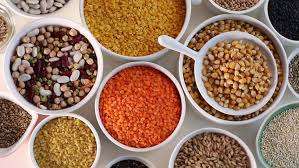The following page describes everything about Grain Cereals fruit. It tellswhat is Grain Cereals meaning, and what do we call Grain Cereals in Hindi. Some hidden facts also like the health benefits of Grain Cereals dry fruit and much more. This page describes facts about Grain Cereals . It tells Value of Grain Cereals including Minerals and Vitamins in Grain Cereals fruit and describes what are the natural benefits and curative properties of Grain Cereals with Health Benefits of Grain Cereals.
Description of Grain Cereals
Following is the Description of Grain Cereals. It includes Grain Cereals color and some more information about Grain Cereals–
Grains are generally classified as the seeds of cereal plants. They are characterized by their smallness, hardness and low water content. Most of them belong to the family of grasses, known scientifically as the family of Gramineae. The ancient Romans called Demeter, the Greek goddess of the grains and harvests, Ceres. The word cereal is derived from her name. Cereals have been the staple human diet from prehistoric times because of their wide cultivation, good keeping qualities, blend flavour and great variety, Each of the cereals has characteristic properties and uses. The cultivation of grains for human consumption was probably developed around 10,000 B.C. It signified the commencement of the era of stable civilisation from the primitive unsettled nomadic life. Ground cereal converted into bread for meal revolved soon thereafter. Cereals have been modified and improved by centuries of cultivation and selective breeding. Cereals consist of tour essential parts, namely i) the husk, hull or chaif, the outer covering loosely attached to the grain, ii) the bran or the outer coat of the grain itself, iii) the germ or embryo and iv) the endosperm which contains nutrients comprising a considerable volume of starch, a small amount of protein and a little fat. There are numerous varieties of cereals of which the most important are rice, wheat maize, millets oats and barley.
Value of Grain Cereals
Grain Cereals nutrition is another matter of knowledge. So here we are providing Grain Cereals nutritional value which actually tellabout Grain Cereals nutrients and their benefits.
The whole grains of all cereals have a similar chemical composition and nutritive value. They are classified as carbohydrate-rich foods, for their average carbohydrate content is 70 per cent per 100 grm. They provide energy and also some protein which is usually of good quality. The protein content of grains varies from 11.8 per cent for wheat to 8.5 per cent for rice per 100 gm. Whole cereals are good sources of calcium and iron but they are totally devoid of ascorbic acid and practically devoid of vitamin A activity. Yellow maize is the only cereal containing appreciable amounts of carotene. Whole grain cereals also contain significant amounts of B group of vitamins. For a balanced diet, cereals should be supplemented by other proteins, minerals and vitamin A and C found in nuts, seeds, milk, fruits and fresh green vegetables. Whole grain cereals play an important role in the diet. It sprouted; they provide an increase in protein balance, as well as in all other nutrients, especially vitamin C. Their complex form of carbohydrate, when in the whole state, is valuable for digestive needs, especially in providing excellent sources of vital fibre.
Natural Benefits and Curative Properties of Grain Cereals
Grain Cereals has a lot of curative properties and natural benefits. Read this passage to find benefits of Grain Cereals–
All grains can be ground into flour for baking nourishing bread, cookies and cakes. In prehistoric days, flour was used when fresh food was scarce; even then it was only used immediately and being freshly ground so that it contained most of the original nourishment of the grain. The modern-day use of steel mills has resulted in a very fine grade of flour, with the consequence considerable loss of nutrients. Thus the modern grain loses so much nourishment when hulled, refined, ground, sterilised and bleached that the result is a grossly undernourished powder. Wheat is by far the most popular flour, but there is a significant difference between wholemeal wheat and plain white wheat flour. In the refining process of whole wheat, the precious wheat germ, which is the very life of grain, is removed. The wheat germ contains the all-important vitamin E The refining of grains to retain only the endosperm has a commercial basis as the refined material appears cleaner, tastes better and is easier in making bread, pastries and other delicacies. But the refined products made after the removal of germ and bran, lack suit ic lent bulk and leads to numerous degenerative diseases and even cancer.


